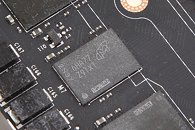Wednesday, March 1st 2017

NVIDIA's AIC Partners to Launch GTX 1080, 1060 With Faster GDDR5, GDDR5X Memory
At their GDC event yesterday, NVIDIA announced a change to how partners are able to outfit their GTX 1080 and GTX 1060 6 GB models in regards to video memory. Due to improvements in process and scaled-down costs, NVIDIA has decided to allow partners to purchase 11 Gbps GDDR5X (up from 10 Gbps) and 9Gbps (up from 8 Gbps) GDDR5 memory from them, to pair with the GTX 1080 and GTX 1060 6 GB, respectively. These are to be sold by NVIDIA's AIB partners as overclocked cards, and don't represent a change to the official specifications on either graphics card. With this move, NVIDIA aims to give partners more flexibility in choosing memory speeds and carving different models of the same graphics card, with varying degrees of overclock, something which was particularly hard to do on conventional 10 Gbps-equipped GTX 1080's, which showed atypically low memory overclocking headroom.

36 Comments on NVIDIA's AIC Partners to Launch GTX 1080, 1060 With Faster GDDR5, GDDR5X Memory
It's particularly ironic having 1060 3Gb, which actually isn't really 1060.
The GTX1060 6GB is a well balanced card with it's not-to less not-to-much 6GB usable vram vs horsepower.
Before that happens we are years further and RX480 will be obsolete.;)
I see this like a "I'm here" from NVIDIA.
And like mentioned, this is purely about texture quality/size, that has almost zero impact on the performance but does improve quality.
You just need the space to store them which the RX480 with 8gb provides.
I'm not really arguing that 8GB isn't overkill(IMO, it is). I'm just pointing out that games do use more than 4GB of VRAM now, and is isn't always the case that the settings have to be turned up so high that it overwhelms the power of the GPU.
At the same time, I'd say that games don't need to use more than 4GB to look good. The shadow cache option makes very little visual difference. And I'd be just as happy playing RE7 on a RX 480 4GB as on an 8GB. And most of the games that use more than 4GB of RAM, actually run just fine on 4GB cards as well without tweaking any settings. Look at Rise of the Tomb Raider as an example. Even at 1080 it will use over 6GB of RAM, just because it is cramming as many textures as possible into VRAM, even alot that aren't being used. But, unlike RE7, it actually runs just fine without stuttering on cards with only 4GB of RAM. Just because the game knows how much VRAM is there, and will only load up textures that are important and actually used first, then fill the rest of the unused VRAM with less important textures that might be used next. It is using the VRAM as basically a texture cache. Less VRAM just means a smaller left over amount of VRAM, and a smaller cache size.
Not seeing the GTX 1070 is both logical and confusing. Logical, because restricting it to 8Gbps makes it have a larger performance gap to GTX 1080 11Gbps and GTX 1060 9Gbps, which would balance NVIDIA's product stack a bit better. Confusing, because I'm sure a 9Gbps GTX 1070 would sell well.
But yeah I agree, 9Ghz stock speed vram would be cool, you should be able to OC it to 10GHz then!:pimp: